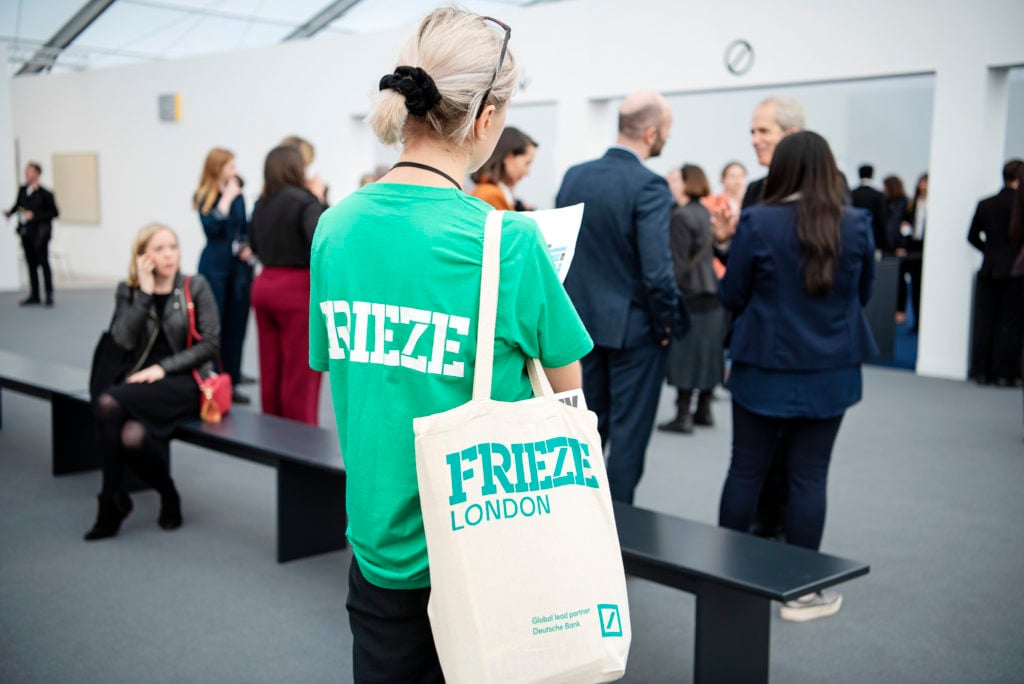Art Industry News is a daily digest of the most consequential developments coming out of the art world and art market. Here’s what you need to know on this Tuesday, May 26.
NEED-TO-READ
Prince Charles Issues Warning on the Future of the Arts – The Prince of Wales, a patron of several arts institutions in the UK, is sounding the alarm over the precarious financial situations faced by cultural organizations across the country. In an interview with Classic FM, he said it was paramount that the country “find a way of keeping orchestras and other arts bodies going,” adding that they are of “enormous importance” to the economy. The National Theatre, Royal Shakespeare Company, and the Southbank Centre are all facing financial collapse due the loss of income from the lockdown. (BBC)
Museums Collect Pandemic Artifacts – The Museum of the City of New York is among an increasing number of museums around the world that are acquiring items documenting the coronavirus pandemic. The institution has acquired around 4,000 photos related to daily life amid the global health crisis, while the Autry Museum of the American West has acquired 160 items, including illustrated journals. In addition, the 12 Smithsonian museums will also begin collecting such items via digital submissions. (New York Times)
Another Uproar Over the Humboldt Forum – A Christian cross to be installed atop the new museum’s dome on Friday is igniting further debate about the beleaguered $700 million institution. Germany’s culture minister, Monika Grütters, says the large cross is a symbol of charity, freedom, cosmopolitanism, and tolerance. Critics say the cross is an inappropriate symbol to put atop a museum that holds a large amount of objects collected from Africa during Germany’s colonial era. (Monopol)
Philadelphia Museum of Art Workers Seek to Unionize – Staff at the Philadelphia Museum of Art have filed a petition with the US National Labor Relations Board in a move to unionize and join the American Federation of State, County, and Municipal Employees (AFSCME), one of the country’s biggest labor unions. The workers are hoping that forming a union will ensure the museum prioritizes worker and visitor safety as it begins to crawl its way out of a financial hole created by the pandemic. (Artforum)
ART MARKET
Marie Antoinette’s Travel Trunk Sells for Nearly €44,000 – The Queen of France’s trunk, with inscriptions on its cover in small brass nails that read, “Queen’s Bedroom #10,” sold for €43,750 ($47,843), well above its estimate of €8,000 to €10,000, in a sale at Versailles. A serviette from her coronation sold for €14,500 ($15,800). (Guardian)
What Can the Art Market Learn From Banking? – Patric Johnson, a former investment banker and now managing partner at art advisory firm Beaumont Nathan, says that “real confidence” in the art market will only bounce back when a coronavirus vaccine is made widely available. He says “fluff-value” artworks made by some of today’s busiest artists could lose as much as 40 percent of their value. “The economy is falling off a cliff so transient demand will go away.” (Financial Times)
COMINGS & GOINGS
The Southbank Center Will Struggle to Reopen This Year – London’s Southbank Center, which includes the Hayward Gallery, may not reopen until April 2021. The Centre, which has been closed since March 17, anticipates losing at least £5.1 million ($6.2 million) this financial year after running through its reserves and using £4 million ($4.91 million) from the government’s furlough program. (BBC)
Edinburgh Gallery Reopens as Climate House – The contemporary art space Inverleith House in Edinburgh will reopen this year under a new name: Climate House. The space, which opens with a Keg de Souza installation, will be partly programmed with the Serpentine Galleries as part of a “Back to Earth” initiative. (ArtReview)
FOR ART’S SAKE
National Geographic Society Defends Plan to Remove Sculpture – The National Geographic Society in Washington, DC, is defending its decision to remove an art installation from its courtyard to make way for a new building. In what amounts to a burn, the organization says that Elyn Zimmerman’s 1984 installation, Marabar, in neither a historic landmark nor a feature that “draws attention.” (The Art Newspaper)
Conservators Face Off With Lockdown Rats – Conservators have been mostly relying on on-site engineers and climate technology to safeguard museum collections during lockdown. With lights turned off and less dust from visitors to harm the works, among the main concerns are possible infestations from insects and small rodents that are attracted to unoccupied spaces. (TAN)
Cleveland Museum of Art Launches Slack App – The Cleveland Museum of Art has launched an app for Slack that would allow companies to curate their own virtual exhibitions from its collection. ArtLens for Slack, as the project is called, promises “brief but significant moments of companionship, humor, and serendipity woven into the workday,” using CMA’s art to assist “in-office watercooler conversations.” (ARTFIXdaily)
Children’s Book Illustrator Creates Quarantine Book – The children’s book illustrator Steph Plant has created a quarantine edition of Richard Scarry’s 1968 children’s story What Do People Do All Day? In Plant’s edition, the animals of Busytown are occupied with projects such as “frantic home improvement” and “snooping on the neighbors.” (Instagram)






